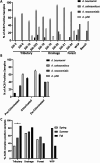Acinetobacter calcoaceticus-baumannii complex prevalence, spatial-temporal distribution, and contamination sources in Canadian aquatic environments
- PMID: 39240108
- PMCID: PMC11449026
- DOI: 10.1128/spectrum.01509-24
Acinetobacter calcoaceticus-baumannii complex prevalence, spatial-temporal distribution, and contamination sources in Canadian aquatic environments
Abstract
Acinetobacter calcoaceticus-baumannii (ACB) complex has been identified as a group of emerging opportunistic pathogens that cause nosocomial infections. The current study investigates the prevalence, distribution, and diversity of pathogenic ACB complex in various aquatic systems with different uses. Of the total 157 agricultural, raw drinking water intake, recreational beach, and wastewater treatment plant (WWTP) effluent samples, acinetobacters were isolated, quantified, and confirmed by genus- and ACB complex-specific PCR assays. Of all agricultural surface water samples, A. calcoaceticus (65%) was more frequently detected than A. pittii (14%), A. nosocomialis (9%), and A. baumannii (3%). In WWTP effluent samples, A. baumannii was more prevalent in de-chlorinated (60%) samples compared to both A. pittii and A. nosocomialis (40%). Interestingly, A. nosocomialis (43%), A. calcoaceticus (29%), and A. baumannii (14%) were detected in raw drinking water intake samples, whereas A. pittii (50%) and A. nosocomialis (25%) were detected in beach samples. Although no sampling location-specific differences were recorded, significant (P < 0.05) seasonal differences were observed when agricultural surface water samples collected in spring were compared with the summer and fall. Whereas effluent chlorination significantly impacted the degree of prevalence of Acinetobacter in WWTP effluent samples, overall, the prevalence of ACB complex in all sampling locations and seasons indicates that these water sources, containing human-associated ACB complex, may pose potential health risks as community-acquired opportunistic infections.IMPORTANCEAcinetobacter calcoaceticus-baumannii (ACB) complex is a group of organisms known to cause problematic nosocomial opportunistic infections. A member of the species complex, A. baumannii, is becoming a global threat to infection treatment as strains are increasingly develop resistance to antibiotics. The prevalence and distribution of potentially pathogenic Acinetobacter calcoaceticus-baumannii complex species remain poorly understood, and there is a need to better understand the occurrence of A. baumannii in non-nosocomial environments. Our research details the spatial-temporal distribution of ACB complex species in a regional watershed and highlights the presence of ACB complex in wastewater effluent that is discharged into a river. These findings deepen our understanding of this group of species in non-nosocomial environments and encourage the development of monitoring programs for these species in regional waters.
Keywords: Acinetobacter calcoaceticus-baumannii complex; agriculture; beach water; environment; surface water; wastewater.
Conflict of interest statement
The authors declare no conflict of interest.
Figures




Similar articles
-
Molecular Epidemiology and Clinical Impact of Acinetobacter calcoaceticus-baumannii Complex in a Belgian Burn Wound Center.PLoS One. 2016 May 25;11(5):e0156237. doi: 10.1371/journal.pone.0156237. eCollection 2016. PLoS One. 2016. PMID: 27223476 Free PMC article.
-
Recurrent bacteremia caused by the Acinetobacter calcoaceticus-Acinetobacter baumannii complex.J Clin Microbiol. 2012 Sep;50(9):2982-6. doi: 10.1128/JCM.01194-12. Epub 2012 Jul 3. J Clin Microbiol. 2012. PMID: 22760035 Free PMC article.
-
Acinetobacter calcoaceticus-Acinetobacter baumannii complex species in clinical specimens in Singapore.Epidemiol Infect. 2012 Mar;140(3):535-8. doi: 10.1017/S0950268811001129. Epub 2011 Jun 21. Epidemiol Infect. 2012. PMID: 21733253
-
Acinetobacter spp. in food and drinking water - A review.Food Microbiol. 2021 May;95:103675. doi: 10.1016/j.fm.2020.103675. Epub 2020 Nov 7. Food Microbiol. 2021. PMID: 33397609 Review.
-
Genotyping methods for monitoring the epidemic evolution of A. baumannii strains.J Infect Dev Ctries. 2015 Apr 15;9(4):347-54. doi: 10.3855/jidc.6201. J Infect Dev Ctries. 2015. PMID: 25881522 Review.
References
MeSH terms
Substances
Grants and funding
LinkOut - more resources
Full Text Sources

